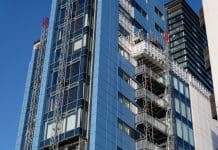Robert Biggs, Scheme Ambassador and Former Chair for the Considerate Constructors Scheme discusses how the industry can help to safeguard its workforce against occupational cancers…
The Considerate Constructors Scheme ‘Spotlight On’ series of campaigns aims to raise awareness of critical issues throughout the construction industry. The Scheme was established by the construction industry to improve its image – and as we know, image is far more than just appearance. By highlighting key issues that affect the workforce, the Scheme plays a vital role helping to raise standards across the industry.
Construction is by its very nature, a physically demanding industry – with many of the workforce being on site, up ladders, underground, drilling, demolishing and creating safe structures for society’s future. Whilst construction work is visible, many of the health risks for the workforce are not always obvious – especially those that are completely undetectable, often remaining dormant for decades.
- Construction workers have a 6 times greater risk of developing skin cancer than the general population (Construction Enquirer, 2015).
- In the UK there are 14,000 newly occurring cases of occupational cancer per year (IOSH, 2015).
- In 2015, an estimated 3,500 construction workers will die from cancer caused by past exposures to asbestos, 500 more from silica dust, and another 5,500 will be diagnosed with occupational cancer (Breathe Freely, BOHS, 2015).
The construction workforce is at a greater risk of developing cancer at work compared with any other industry group, if the risks posed fail to be appropriately managed. The two main types that significantly affect individuals working within the construction industry are skin and lung cancer. They can be caused by exposure to carcinogens and UV radiation in the workplace over a prolonged period of time. The causes can also take various forms from solid substances to gases and dust. A number of substances potentially causing risk are asbestos, silica, diesel engine exhaust emissions, paint and prolonged exposure to UV radiation. Without appropriate control measures in place, the workforce can be harmfully exposed by breathing in these substances or absorbing them through the skin.
It is difficult to determine the true extent of occupational cancers as in many cases individuals fail to develop any noticeable symptoms of either skin or lung cancers until many years later. Therefore, they are often not viewed as a high risk health and safety issue immediately affecting the workforce. Awareness and early intervention is crucial for prevention. It is vital to:
1. Proactively remove carcinogenic and hazardous substances
If complete elimination isn’t achievable, working methods and equipment must be substituted for safer alternatives.
2. Isolate high risk areas
Specific areas should be designated at a distance from main working areas, or workers should be removed from areas of hazardous operations. Those who are exposed can be properly protected during operations, such as cutting timber or cement blocks.
3. Introduce controls to reduce exposure
Measures to minimise exposure to dust and fibres include implementing a ventilation system or installing local exhaust ventilation systems on woodworking machinery. Dust bags can be integrated on power tools for sanding and cutting, and spray booths can be installed for particularly hazardous operations.
Certain controls can be employed to reduce the amount of harmful exposure operatives have to UV radiation such as providing shade, sun cream protection, reflective Personal Protective Equipment (PPE), modifying reflective surfaces and using window tinting on vehicles.
4. Review and update safe working procedures
Outdoor work can be rescheduled to ensure that it does not take place in the middle of the day when UV levels are at their strongest. Jobs could be moved into shaded areas, outdoor tasks shared and staff rotated so the same person is not always working outside in the sun.
5. PPE should be adapted to match the working conditions
PPE could be used alongside other control measures such as dust masks and respirators to protect against fumes. Gloves, overalls, neck protectors, sun cream and sun hats could also be provided for the workforce.
6. Raise awareness and offer appropriate support and advice
The construction industry should be aiming to acknowledge and address dust and UV related issues. Sites should educate and inform the workforce about the dangers of occupational cancers via regular toolbox talks, nurse visits, posters and leaflets. A clear message needs to be communicated to everyone and equipment should be provided and made available to ensure that workers are able to protect themselves.
The importance of protection for the long-term health of the workforce has to be carefully considered and reinforced amongst workers. The industry has to better safeguard against occupational cancers, providing more awareness, guidance and support is essential to achieve this goal.
If the industry wants to attract talented, new recruits, it must ensure it is doing everything it can to provide a safe working environment for today and the future, considering both the short term and long term health impacts and risks involved.
Further information is available at: http://www.ccscheme.org.uk/index.php/spotlight-on-occupational-cancers
Visit the Scheme’s Best Practice Hub – a unique database available to anyone free of charge. TheHub hosts a wealth of best practice examples, innovations and case studies to help the construction industry learn from their peers and raise standards throughout the industry.
Biography
Robert Biggs
Robert is a chartered civil and structural engineer with over 40 years’ experience in the industry. A former director of environmental services at Hackney LBC, Robert now runs a building engineering and management consultancy specialising in building regulations and allied services. Robert is a former president of the Association of Building Engineers (now the CABE) and a former Scheme Chair. ■
. . . . . . . . . . . . . . . . . . . . . . . . . . . . . . . . . . . . . . . . . . . . . . .
Robert Biggs
Scheme Ambassador and Former Chair
Considerate Constructors Scheme
Tel: 0800 783 1423
enquiries@ccscheme.org.uk













